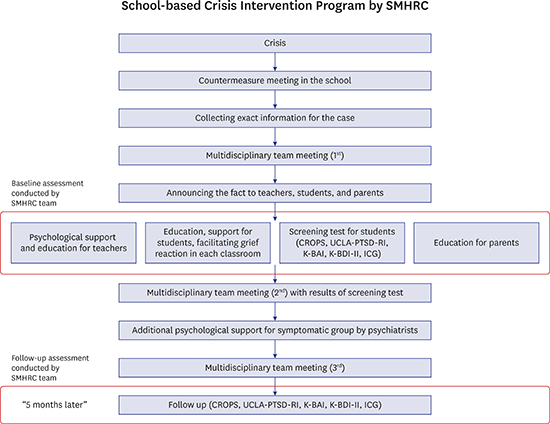1. World Health Organization. Preventing Suicide: a Resource for Media Professionals, Update 2017. Geneva: World Health Organization;2017.
2. Cougle JR, Resnick H, Kilpatrick DG. PTSD, depression, and their comorbidity in relation to suicidality: cross-sectional and prospective analyses of a national probability sample of women. Depress Anxiety. 2009; 26(12):1151–1157.

3. Black PJ, Woodworth M, Tremblay M, Carpenter T. A review of trauma-informed treatment for adolescents. Can Psychol. 2012; 53(3):192–203.

4. Aguirre RT, Slater H. Suicide postvention as suicide prevention: improvement and expansion in the United States. Death Stud. 2010; 34(6):529–540.

5. Campbell FR, Cataldie L, McIntosh J, Millet K. An active postvention program. Crisis. 2004; 25(1):30–32.

6. Grossman J, Hirsch J, Goldenberg D, Libby S, Fendrich M, Mackesy-Amiti ME, et al. Strategies for school-based response to loss: proactive training and postvention consultation. Crisis. 1995; 16(1):18–26.

7. Kim BN, Kim JW, Kim HW, Shin MS, Cho SC, Choi NH, et al. A 6-month follow-up study of posttraumatic stress and anxiety/depressive symptoms in Korean children after direct or indirect exposure to a single incident of trauma. J Clin Psychiatry. 2009; 70(8):1148–1154.

8. Song SH, Kim BN, Choi NH, Ryu J, McDermott B, Cobham V, et al. A 30-month prospective follow-up study of psychological symptoms, psychiatric diagnoses, and their effects on quality of life in children witnessing a single incident of death at school. J Clin Psychiatry. 2012; 73(5):e594–e600.

9. McLaughlin KA, Koenen KC, Hill ED, Petukhova M, Sampson NA, Zaslavsky AM, et al. Trauma exposure and posttraumatic stress disorder in a national sample of adolescents. J Am Acad Child Adolesc Psychiatry. 2013; 52(8):815–830.e14.

10. Strand VC, Sarmiento TL, Pasquale LE. Assessment and screening tools for trauma in children and adolescents: a review. Trauma Violence Abuse. 2005; 6(1):55–78.
11. Lee KM, Jeong SH, Lee WK, Chung US. Reliability and validity of the Korean version of the Child Report of Post-Traumatic Symptoms (CROPS) and the Parent Report of Post-Traumatic Symptoms (PROPS). J Korean Acad Child Adolesc Psychiatry. 2011; 22(3):169–181.

12. Kim TH, Han DH, Yoo SK, Lee JJ, Kim JE, Chung US. Validation study of a Korean version of the abbreviated University of California, Los Angeles, PTSD Reaction Index (Abb-UCLA-PTSD RI) for adolescents. J Korean Med Sci. 2018; 33(5):e37.

13. Beck AT, Steer RA. Manual for the Beck Anxiety Inventory. San Antonio, TX: The Psychological Corporation;1990.
14. Yook SP, Kim JH. A clinical study on the Korean version of Beck Anxiety Inventory: comparative study of patient and non-patient. Korean J Clin Psychol. 1997; 16(1):185–197.
15. Beck AT. Depression: Causes and Treatment. Philadelphia, PA: University of Pennsylvania Press;1972.
16. Yu B, Lee HK, Lee K. Validation and factor structure of Korean version of the Beck Depression Inventory second edition (BDI-II): in a university student sample. Korean J Biol Psychiatry. 2011; 18(3):126–133.
17. Lee EH, Lee SJ, Hwang ST, Hong SH, Kim JH. Reliability and validity of the Beck Depression Inventory-II among Korean adolescents. Psychiatry Investig. 2017; 14(1):30–36.

18. Han DH, Lee JJ, Moon DS, Cha MJ, Kim MA, Min S, et al. Korean version of Inventory of Complicated Grief scale: psychometric properties in Korean adolescents. J Korean Med Sci. 2016; 31(1):114–119.

19. Adams ZW, Sumner JA, Danielson CK, McCauley JL, Resnick HS, Grös K, et al. Prevalence and predictors of PTSD and depression among adolescent victims of the Spring 2011 tornado outbreak. J Child Psychol Psychiatry. 2014; 55(9):1047–1055.

20. Fletcher KE. Childhood post-traumatic stress disorder. In : Mash EJ, Barkley RA, editors. Child Psychopathology. New York, NY: The Guilford Press;1996. p. 242–276.
21. Alisic E, Zalta AK, van Wesel F, Larsen SE, Hafstad GS, Hassanpour K, et al. Rates of post-traumatic stress disorder in trauma-exposed children and adolescents: meta-analysis. Br J Psychiatry. 2014; 204(05):335–340.

22. Wang CW, Chan CL, Ho RT. Prevalence and trajectory of psychopathology among child and adolescent survivors of disasters: a systematic review of epidemiological studies across 1987-2011. Soc Psychiatry Psychiatr Epidemiol. 2013; 48(11):1697–1720.

23. Hong SB, Youssef GJ, Song SH, Choi NH, Ryu J, McDermott B, et al. Different clinical courses of children exposed to a single incident of psychological trauma: a 30-month prospective follow-up study. J Child Psychol Psychiatry. 2014; 55(11):1226–1233.

24. Garza K, Jovanovic T. Impact of gender on child and adolescent PTSD. Curr Psychiatry Rep. 2017; 19(11):87.

25. Loos S, Wolf S, Tutus D, Goldbeck L. Frequency and type of traumatic events in children and adolescents with a posttraumatic stress disorder. Prax Kinderpsychol Kinderpsychiatr. 2015; 64(8):617–633.
26. O'Toole BI, Catts SV, Outram S, Pierse KR, Cockburn J. The physical and mental health of Australian Vietnam veterans 3 decades after the war and its relation to military service, combat, and post-traumatic stress disorder. Am J Epidemiol. 2009; 170(3):318–330.
27. Yule W, Bolton D, Udwin O, Boyle S, O'Ryan D, Nurrish J. The long-term psychological effects of a disaster experienced in adolescence: I: the incidence and course of PTSD. J Child Psychol Psychiatry. 2000; 41(4):503–511.

28. National Institute for Health and Care Excellence. Post Traumatic Stress Disorder: The Management of PTSD in Adults and Children in Primary and Secondary Care (Clinical Guideline 26). London: Gaskell and the British Psychological Society;2005.
29. Andriessen K, Beautrais A, Grad OT, Brockmann E, Simkin S. Current understandings of suicide survivor issues: research, practice, and plans. Report of the 1st International Suicide Postvention Seminar, September 8, 2006, Portoroz, Slovenia. Crisis. 2007; 28(4):211–213.
30. Joseph S, Yule W, Williams R, Andrews B. Crisis support in the aftermath of disaster: a longitudinal perspective. Br J Clin Psychol. 1993; 32(Pt 2):177–185.

31. Poijula S, Wahlberg KE, Dyregrov A. Adolescent suicide and suicide contagion in three secondary schools. Int J Emerg Ment Health. 2001; 3(3):163–168.
32. Trickey D, Siddaway AP, Meiser-Stedman R, Serpell L, Field AP. A meta-analysis of risk factors for post-traumatic stress disorder in children and adolescents. Clin Psychol Rev. 2012; 32(2):122–138.










 PDF
PDF Citation
Citation Print
Print




 XML Download
XML Download